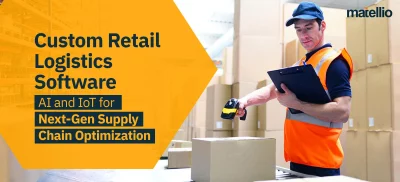
Many industries, including eCommerce, retail, healthcare, manufacturing, etc., rely directly on the supply chain. Whether it is about ensuring inventory stocking or delivering happiness to the customer’s doorsteps, the supply chain is at the heart of this business. No wonder the supply chain has received worldwide attention helping it evolve over the years. The role of the supply chain has become more prominent with business pacing up to meet dynamic customer demands.
IoT has enabled this supply chain era to become more streamlined. 39% of the businesses believe that IoT is a priority implementation to stay ahead of the competition curve. World leaders in the supply chain have affirmed that IoT brings more value to their businesses and helps them boost their revenue by streamlining almost every aspect of it.
However, some supply chain businesses are still on the fence about the effectiveness of IoT in supply chain. How it helps, and how one can invest in IoT development services. This blog covers all these aspects and many more. Let’s get started.
IoT in Supply Chain Use Cases
1. Real-Time Fleet Monitoring
Real-time monitoring is one of the key aspects of the business. In the era of order tracking and express delivery options, having the right set of fleet monitoring solutions is vital to business success. The dynamic market requirements further make real-time fleet monitoring a must-have for organizations, regardless of the size and target market.
IoT product development in supply chain makes it easier for businesses to achieve this level of monitoring. They can use dashboards and real-time GPS maps to locate their fleets and even forecast their arrival. IoT systems garner all the important information about the fleet, such as current location, expected duration between the next milestone, driver behavior, and more. This information helps key stakeholders to make smart business decisions that maximize profits.
2. Storage Condition Monitoring
About 40% of the business revenue is lost in product wastage due to inaccurate environmental conditions during transportation. Intel also shows that 40% of the perishable goods are spoilt before they reach the customers. Due to this, organizations worldwide lose billions of money due to the transportation of goods and products in less-than-less-than-optimal conditions.
This has encouraged businesses to invest in IoT development services to gear up against the challenge. The network of IoT devices at every point of the supply chain helps businesses stay updated about the conditions of goods and products during transportation. This is more effective in transporting perishable goods, wherein brands can monitor the temperature and environment in real-time. They can also react on time if environmental conditions go lower or higher than the threshold.
3. Forecast Order Arrival and Delivery
IoT helps retailers and businesses to bring accuracy in predicting product delivery. IoT-connected devices bring real-time information about the fleet and help understand the potential delay causes on the way. They allow you to track patterns and trends during transportation to get a clearer idea about the route. Having all this information at their fingertips helps businesses calculate the expected delivery time to ensure maximum customer satisfaction.
Also Read: How to Develop an IoT-Based App for Driver Management?
4. Contingency Planning and Risk Mitigation
IoT devices all the required information to anticipate risk factors and mitigate them timely. For instance, suppose you have a fleet on a mountain route. Although the route was clear when the fleet began from the departure location, it was observed that due to a landslide, it had been blocked. Since real-time monitoring solutions delivered this information timely to the decision-makers, they could communicate this information to the driver who took a detour and reached safely. This is exactly how supply chain management solution helps deliver real-time data for contingency planning.
5. Route Optimization
Imagine the fleet is operating smoothly until it gets stuck in a road jam for six hours. The consequences can be dire and even impact the delivery cycle. Shipments can be deployed, causing cancellations and even distrust from the buyers. IoT-based fleet management solutions work on devices across locations. They collect information in advance to help you change the route if needed.
Also Read: Discover how custom multi-warehouse inventory management software can revolutionize your supply chain with optimized operations and smarter inventory control.
How to Implement IoT in Supply Chain Operations in Your Business?
IoT in the supply chain does not only include the specific development area. As a business, you must also be prepared to build the right hardware and software infrastructure for IoT development. The key is to align the IoT development services with your goals and challenges to deliver long-term value. While organizations may not always have the right technological acumen to accommodate these requirements, they hire an IoT development company to take care of this.
They don’t only offer the technical expertise required for IoT app development but also enrich your journey with IoT consulting. They work with you to understand what goals and challenges you have in mind. At the same time, they also uncover the possibilities you are missing.
A best-in-class IoT development company will bring the following USP to the table:
- Years of experience in IoT development services
- Hands-on experience in building IoT solutions for supply chain
- Quality reflected in the past products
- Positive reviews and feedback from the previous clients
- Overview and expertise of their IoT projects
- Additional USPs in IoT development
And most importantly, a proven IoT development process. Let’s help you understand this with the process with follow at Matellio.
1. Analyzing Your Business Readiness for IoT and Identify the KPIs
The first stage, as discussed above, is to understand what you are trying to achieve with the investment in IoT development services. Through our IoT consulting services, we help you highlight the gaps in your planning and how you can fill them with our IoT development services. We also list down the KPIs against which you can analyze the progress of custom IoT development.
This helps us build the success roadmap for you and see if any aspects need to be taken care of. For instance, IoT devices bring data from widely spread devices which requires robust data management solutions. Let’s see which questions you might need an answer to:
a. What data management tools are you using for implementing IoT in Supply Chain?
IoT software development comes with a lot of data and only grows with time. Your team needs to ensure that this data is securely saved. Any data breach may damage your business reputation and cause the loss of very important business data.
b. Is your security infrastructure up for the challenge?
The higher number of devices means higher entry points for cyber security threats. This risks your data, requiring a strong security backup in encryption, blockchain, frameworks, etc.
c. How to integrate IoT solutions with legacy systems?
We follow standardized processes and industry guidelines as an IoT development company. We understand the IoT system should be extensible to the existing ERP solutions.
Our IoT consultation experts can help you here. With our experience delivering IoT solutions for global supply chain organizations, we have the right technology insight and understanding. Our expertise can help you create the right IoT implementation strategy and maximize your returns from the investment.
Also Read: Supply Chain Management Software Development: Cost & Features
2. IoT Development
Matellio follows an agile methodology for custom IoT development. These are the stages that we generally go through.
Step 1: Discovery of all the IoT development requirements for your business
Step 2: SRS creation with scope freezing
Step 3: UI/ UX development
Step 4: Hardware/ software development
Step 5: QA and testing
Step 6: Bug fixes
Step 7: Deployment
Also Read- IoT Software Development: A Complete Guide
Choose Us for a Smoother IoT Development Experience
IoT has forced supply chain businesses to redefine how they work. They help businesses revolutionize the processes to ensure better revenue and higher value, not just for their business but even for the customers. At Matellio, we enable supply chain organizations to become competitive with advanced IoT development services.
Carefully crafted to meet the technology demands of growing businesses, regardless of the size, Matellio’s development methodology takes care of everything you need for your growth journey. Our IoT development experts are certified in the domain and have the right industry exposure to add value to your IoT development initiative. Book a FREE consultation call with our experts to know more about how we can help you.





